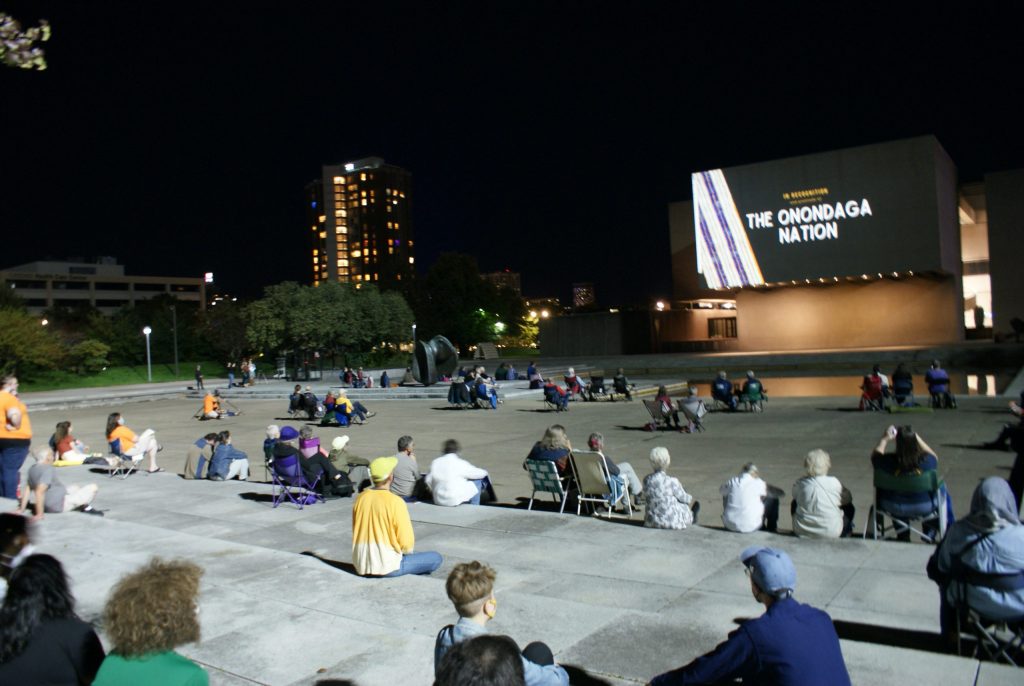Haudenosaunee films highlight Indigenous Peoples’ Day
Haudenosaunee shows films for Indigenous Peoples' Day

Indigenous Peoples’ Day was celebrated on Monday with the Refocus: Haudenosaunee Films gathering at the Everson Museum of Art Plaza.
Women of Italian and Syracuse Heritage in Central New York (WISH CNY) and Neighbors of the Onondaga Nation (NOON) partnered with Light Work’s Urban Video Project to sponsor the event.
“People can learn the true history of America, what it was built on, and whose land it was built on,” said Sunny Guyette, of Syracuse.
Prior to the film showing, many gathered at the Christopher Columbus monument in downtown Syracuse for the Replace Columbus Observance. WISH CNY and NOON, as well as the Resilient Indigenous Action Collective (RIAC), hosted the observance.
The Columbus statue, which was partly funded by Italian dictator Benito Mussolini, was unveiled in Syracuse in 1934. Several guest speakers took the mic to express their wishes for the Columbus statue to be taken down by the city.
Natalie LoRusso of WISH CNY was one of the speakers during the event. Afterwards, she provided more of her thoughts on recognizing indigenous peoples.
“It’s time for us to decentralize what we thought was true when we were growing up,” LoRusso said. “We all learned the names of the ships that Columbus sailed on more than we learned about the names of the people whose land we are on now.”
LoRusso says she has been frustrated by the red tape and the efforts of opposition groups slowing down progress on getting the statue removed, which is why it was important for her group to get the message out.
“We are just trying to spread awareness that this is not going to happen without a serious push from residents,” LoRusso said. “This is our way of telling people what we’re about and hopefully hearing some more perspectives.”
Noel Johnson, of Syracuse, says that a dialogue between Italian-Americans and the Onondaga Nation needs to happen to speed up the statue-removal process.
“A lot of Italian-Americans are thinking that this is a denial of their ethnicity, which it’s not,” Johnson said. “It’s a denial of the actual documented history of Columbus himself.”
A moment of silence was held before the observance. After everyone had spoken, many of the attendees gathered in a semi-circle and raised their hands and their “Celebrate Diversity, Replace Columbus” signs to conclude the demonstration.
After the observance, attendees walked to Everson to view the Haudenosaunee films that were being projected on the outside wall of the museum.
Films celebrating Haudenosaunee culture were contributed by Rematriation Magazine, Indigenous Values Initiative, RIAC and Skän·oñh Great Law of Peace Center.
Joseph Campbell, of the Onondaga Nation, liked what the films provided to the viewers.
“I thought it was really informational and they did a really good job putting everything together,” Campbell said. “People can learn background knowledge about who we are and where we came from and what our traditions are.”
Among the films presented were The Thanksgiving Address, that discussed the thankfulness of the Haudenosaunee, and SKéN:NEN by Santee Smith, which highlighted inspirational indigenous women.
The Refocus event was a way for people in the Syracuse area to center their attention to indigenous peoples on a day that has typically been focused on Christopher Columbus.
“We as a city, as people of different ethnicities, have to give credit and have to recognize the original inhabitants of this area, of this part of the world,” Noel Johnson said.
Johnson hopes more people will recognize the value of Indigenous Peoples’ Day.
“The importance of having this event tonight is to bring the indigenous paradigm up, raise it up, and get it in peoples’ minds that there is another culture that’s here in Syracuse,” Johnson said. “It precedes colonial culture, and it precedes European culture. They were here, and they’re still here.”





